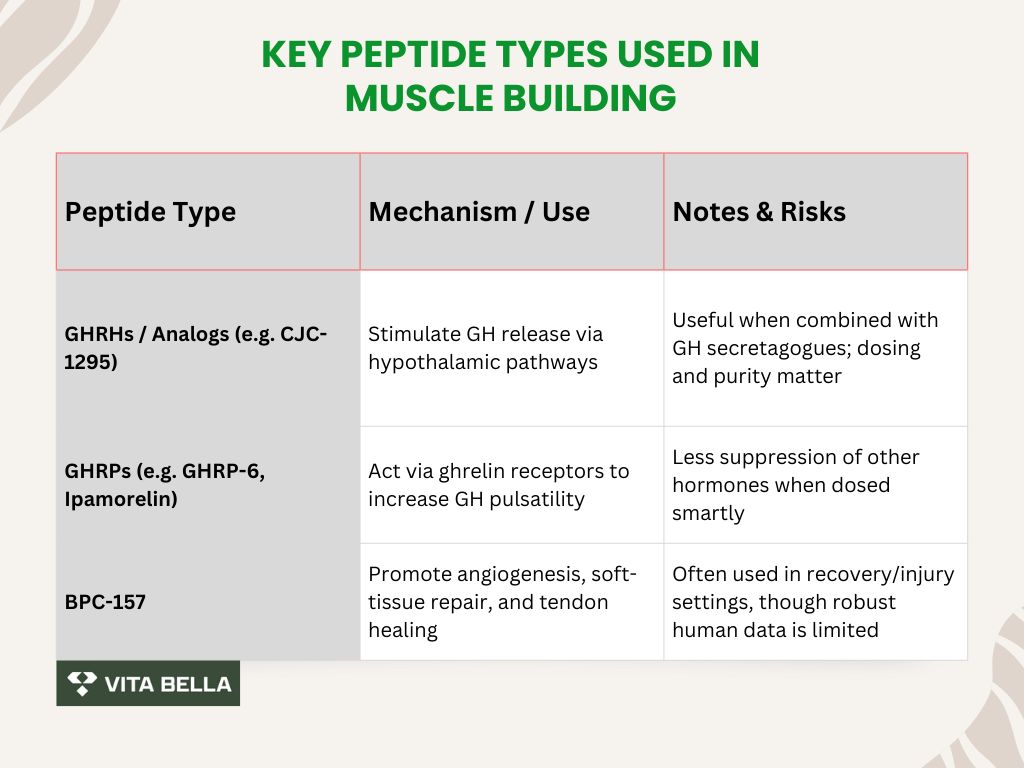Struggling to recover fast enough to see real gains, even with peptide support in mind? Peptides 1 are short chains of amino acids (usually 2–50 residues) that act as signaling molecules, hormones, or modulators in the body. According to a study in sports nutrition 2, bioactive peptides have shown potential to reduce muscle damage, support composition shifts, and enhance muscular performance.
Don’t let inflammation, fatigue, or slow healing keep you from real progress. Vita Bella’s physician-guided peptide therapy helps you repair, grow, and perform at your best safely and effectively. Start your customized plan today and take control of your results.
How Peptides Help in Recovery and Growth?
Peptides support the transition from recovery to muscle growth through several targeted biological pathways:
1- Inflammation Modulation and Oxidative Stress Reduction
Inflammation is a natural response to intense exercise, but prolonged or excessive inflammation can delay healing. Specific bioactive peptides have been shown to regulate inflammatory cytokines and reduce oxidative stress, preventing further tissue breakdown.
By balancing the immune response, these peptides create a more favorable environment for muscle repair and reduce downtime between workouts.
2- Stimulating Growth Hormone / IGF-1 Axes
Research 3 explains that peptide classes, such as GHRPs and GHRHs, act on the hypothalamic–pituitary axis to increase the pulsatile release of growth hormone. This rise in GH triggers the liver and peripheral tissues to produce more insulin-like growth factor 1 (IGF-1), a key hormone involved in protein synthesis, hypertrophy, and recovery. The GH–IGF-1 cascade also promotes fat mobilization, aiding in body composition improvement alongside muscle growth.
3- Matrix Remodeling and Regeneration
Recovery isn’t just about muscle fibers; connective tissues, such as tendons, fascia, and the extracellular matrix (ECM), play essential roles in strength and mobility. Specific peptides accelerate collagen synthesis, enhance fibroblast activity, and support angiogenesis. This improves structural integrity at muscle attachment points, reduces the risk of injury, and enhances long-term durability during intense training cycles.
4- Optimizing Nutrient Sensing and Metabolic Signaling
Muscle protein synthesis relies heavily on how efficiently cells utilize amino acids and energy. Some peptides interact with nutrient-sensing pathways such as mTOR and AMPK, improving cellular uptake and utilization of key nutrients. This enhances the anabolic response to protein intake or resistance training, improving mitochondrial function and leading to better endurance and faster muscular adaptation.
Scientific Evidence about Peptides
The landscape of peptides is promising, but the evidence is still evolving. Reviews have highlighted both the potential benefits and risks. For example, some peptides may carry cancer-promoting risks or off-target effects if misused.
Research 3 indicates that the quality of peptide synthesis, purity, dosing regimens, and combination strategies significantly impact both efficacy and safety. One integrative review 1 highlighted that early human data show peptide benefits in metabolic, musculoskeletal, and behavioral health; human clinical trials remain limited in number, size, and duration.
Also, the review 2 of bioactive peptides in sports nutrition emphasized that many claims come from preclinical or nutritional peptide analogues rather than pharmaceutical-grade performance peptides.
Practical Tips If You Consider Using Peptides
If you’re considering peptides, start by consulting peer-reviewed research and medical guidance to understand safety and purpose. Buy only from reputable sources to avoid contamination or mislabeling. Track your response carefully, keeping dosage consistent and avoiding self-experimentation beyond tested protocols. If someone wants to explore peptide use responsibly, these guiding principles can help:
Start modestly and monitor biomarkers: Use the lowest effective dose and track hormone panels.
Use reliable sources: Purity and chain verification are critical to avoid harmful contaminants.
Combine with training and nutrition: Peptides magnify but don’t replace progress from resistance exercise and protein intake.
Cycle usage: Avoid constant exposure to reduce receptor desensitization or suppression.
Medical supervision: Collaborate with clinicians who are knowledgeable about peptide therapy and closely monitor associated risks.
Peptides: From Inflammation to Innovation
Peptides present a fascinating bridge between recovery and muscle growth. Their molecular precision lets them target healing pathways, modulate stress, and support anabolic signaling. Even so, they are not miracle drugs. They work best when paired with innovative training, good nutrition, and careful clinical oversight.
For fitness enthusiasts and clinic clients alike, the promise of peptides lies in amplifying natural processes, rather than bypassing them. Use them wisely and with respect to safety.
How Injectable Peptides Bridge Recovery and Muscle Development?
Injectable peptides are gaining traction as adjunct therapies in tissue repair and regenerative medicine, with potential applications in muscle recovery and growth. These compounds include growth factor–mimicking peptides, signaling molecules, and scaffolding agents designed to enhance cellular repair processes, collagen synthesis, and local regeneration, e.g, CJC-1295, Ibutamoren (MK-677), and BPC-157.
Study 4 explains that such peptides may complement resistance training by accelerating recovery, reducing downtime, and supporting structural remodeling in soft tissues and muscle fibers. While promising, their use requires clinical validation and oversight to ensure safety and efficacy.

Still Training Hard, But Not Seeing the Results You Deserve?
When inflammation, fatigue, and delayed recovery slow you down, every workout becomes a battle instead of a breakthrough. No amount of training can compensate for poor muscle repair, stressed joints, or hormonal imbalances.
Vita Bella delivers medically guided peptide therapies that accelerate tissue healing, boost anabolic signaling, and restore your body at the cellular level. With targeted recovery support, you can train harder, recover faster, and ultimately perform at your peak without compromising your health. Join today and unlock your true training potential.
FAQs
What exactly are peptides, and how do they impact muscle recovery?
Peptides are short chains of amino acids that act as signaling molecules in the body. Specific peptides can reduce inflammation, support cellular repair, and improve tissue recovery, making them valuable for athletes and individuals experiencing delayed healing.
Are injectable peptides safe to use for muscle growth?
When sourced from reputable providers and used under medical supervision, injectable peptides can be a safe and effective treatment option. However, improper dosing, low-quality products, or unsupervised use may increase risks, which is why clinical guidance is essential.
How do peptides differ from traditional supplements or protein powders?
Unlike protein powders, which provide broad amino acid support, peptides work at a cellular level to trigger specific biological responses, such as growth hormone release, collagen synthesis, or inflammation control. They offer more targeted results compared to general supplements.
Can peptides replace training and nutrition for muscle growth?
No, peptides are designed to enhance the effects of proper training and nutrition, not replace them. When paired with resistance exercise, adequate protein intake, and recovery strategies, they can help accelerate progress and improve overall performance.





















